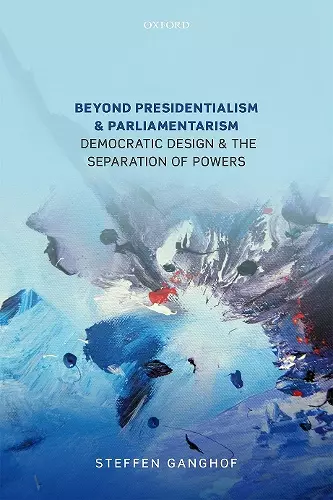Beyond Presidentialism and Parliamentarism
Democratic Design and the Separation of Powers
Format:Hardback
Publisher:Oxford University Press
Published:17th Dec '21
Currently unavailable, and unfortunately no date known when it will be back

This is an open access title available under the terms of a CC BY-NC-ND 4.0 International licence. It is free to read at Oxford Scholarship Online and offered as a free PDF download from OUP and selected open access locations. In a democracy, a constitutional separation of powers between the executive and the assembly may be desirable, but the constitutional concentration of executive power in a single human being is not. Beyond Presidentialism and Parliamentarism defends this thesis and explores 'semi-parliamentary government' as an alternative to presidential government. Semi-parliamentarism avoids power concentration in one person by shifting the separation of powers into the democratic assembly. The executive becomes fused with only one part of the assembly, even though the other part has at least equal democratic legitimacy and robust veto power on ordinary legislation. The book identifies the Australian Commonwealth and Japan as well as the Australian states of New South Wales, South Australia, Tasmania, Victoria, and Western Australia as semi-parliamentary systems. Using data from 23 countries and six Australian states, it maps how parliamentary and semi-parliamentary systems balance competing visions of democracy; it analyzes patterns of electoral and party systems, cabinet formation, legislative coalition-building, and constitutional reforms; systematically compares the semi-parliamentary and presidential separation of powers; and develops new and innovative semi-parliamentary designs, some of which do not require two separate chambers.
This is the most exciting new approach to comparative democratic institutional theory in decades. Ganghof develops a new concept of democratic regime design, "semi-parliamentary". This design partially exists in the world today (principally in Australia, and with some parallels in Germany), but this book fully articulates it as a distinct model of democracy. Ganghof offers a new approach to the concept of separated powers, and guidelines for institutional design that should be heeded by all scholars and practitioners interested in how democracy works, and how it could be reformed to work better. * Matthew S. Shugart, University of California, Davis *
Ganghof's book is path-breaking. He makes a convincing case that the combination of separation of powers via asymmetric bicameralism with a parliamentary system — "semi-parliamentarism" — deserves to be seen as a distinct model of government. Then, he shows how well-designed semi-parliamentary bicameralism is normatively superior to both presidential and parliamentary systems, and how several cases – particularly Australia's state and federal constitutional models – have, by a combination of luck and design, arrived at this fortuitous institutional arrangement. Any one of these would have been a significant contribution. Together, they represent a genuine advance in our understanding of political institutions and democratic governance. * Benjamin Reilly, University of Western Australia *
One of the most important constitutional design choices a country faces is the choice between presidential, parliamentary, and hybrid models. In this impressive new book, Steffen Ganghof examines this choice through both a theoretical and comparative lens, before making a powerful case for hybrid over presidential models. The book is clear, measured, and wide-ranging in scope; and deserves a wide audience among political scientists and constitutional lawyers alike. * Rosalind Dixon, UNSW Sydney *
Ganghof's book is marked by his uniting an innovative way of thinking about institutional design in democracies and a sophisticated grasp of the conceptual complexities inherent in the idea of political equality. His proposal for semi-parliamentary systems, in which directly elected second chambers have veto-power over ordinary legislation but not government confidence and supply, shows how different visions of majority government can be realized simultaneously. One seldom comes away from a study of comparative institutions with a real sense of intellectual excitement, but this work is an exception. * Albert Weale, University College London *
Steffen Ganghof has produced the most interesting contribution to the comparative study of political institutions for many years. * Michael Thies, University of California Los Angeles *
Steffen Ganghof has produced a truly thought-provoking book. He has raised again the discussion of which regime form should be preferable in a democracy. * José Cheibub, Andrew W. Mellon Professor of Political Science at the University of Pittsburgh *
Steffen Ganghof's insightful and inspiring new book invites not only scholars of comparative government, but also political theorists and citizens to use their imagination and think beyond existing institutional orders. * Claudia Landwehr, University of Mainz *
Ganghof's defense of semi-parliamentarism admirably remedies the disconnect between the evaluation of democratic institutions by comparative politics scholars, on one hand, and by normative democratic theorists, on the other. The work also suggests an agenda for normative theorists. It reveals the need for more normative work on different realizations of democracy. * James L. Wilson, University of Chicago *
[U]nlike Linz and subsequent scholars who view the choice between presidentialism and parliamentarism as a stark one involving unavoidable tradeoffs between the direct democratic accountability made available through presidentialism - with its attendant risks of authoritarianism - and a more proportional representation of voters in parliamentarism - with its risks of indecisive elections - Ganghof charts a new path. * Kevin J. Elliott, Yale University *
ISBN: 9780192897145
Dimensions: 240mm x 166mm x 14mm
Weight: 492g
224 pages